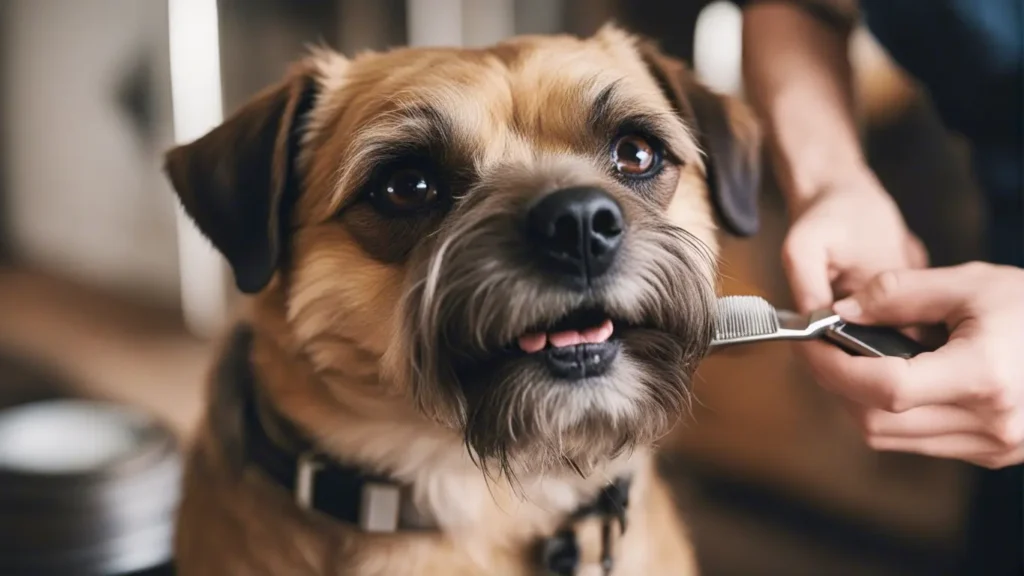As a proud Border Terrier parent, you know this lovable breed makes an excellent companion. Their spunky personality and affectionate nature endear them to families and individuals alike. However, one aspect of living with a Border Terrier that owners must be prepared for is shedding.
While Border Terriers are not excessive year-round shedders, they undergo seasonal shedding cycles. By understanding what causes shedding in this healthy breed and implementing some simple solutions, you can effectively manage your dog’s wiry coat and keep excessive fur at bay. This article will provide an in-depth look at Border Terrier shedding. We’ll cover:
- The unique coat type of the Border Terrier
- Factors that influence shedding
- Typical shedding behaviors
- Seasonal shedding cycles
- Health conditions related to shedding
- Regular grooming tips to control shedding
- Products and tools to reduce shedding
- Household cleaning strategies
- Overall recommendations for managing Border Terrier fur

Let’s get started!
Table of Contents
- 1 The Unique Coat of the Border Terrier
- 2 Typical Shedding Behaviors in Border Terriers
- 3 Seasonal Shedding Cycles in Border Terriers
- 4 Health Conditions Related to Shedding in Border Terriers
- 5 Grooming Tips to Control Shedding in Border Terriers
- 6 Products and Tools to Reduce Border Terrier Shedding
- 7 Household Cleaning Strategies for Managing Border Terrier Fur
- 8 Tips for Managing Border Terrier Shedding
- 9 Related posts:
- 10 10 Border Terrier Puppy Training Techniques for the Best Dog Ever
- 11 12 Fun Facts About Border Terrier Puppies and Their Quirks
- 12 The Complete Guide to Border Terrier Rehoming: What You Need to Know
- 13 8 Essential Border Terrier Health Tips
The Unique Coat of the Border Terrier
The Border Terrier has a dense, wiry outer coat and a soft undercoat. This double coat protects the dog from rain and cold weather and provides sun protection. Their coat is also designed to camouflage the breed when hunting rodents and during fieldwork.
The outer coat should ideally be between 1.5 to 3 inches long and contribute to the ruffled, weather-resistant appearance of the Border Terrier. While trim and neat, the coat should not look soapy or silky, denoting improper coat texture. Border Terriers come in solid colors with minimal markings and patterns. Standard shades include grizzle and tan, red, wheaten, and blue and tan. White may also be present in small amounts on the chest and feet.
This specialized coat means Border Terriers will shed seasonally as the undercoat is blown out and the outer coat is renewed. However, this is normal shedding that can be managed with proper grooming techniques.

Factors That Influence Shedding in Border Terriers
- Several factors can impact the amount of shedding a Border Terrier experiences. These include:
- Seasonal Changes: Border Terriers will shed more heavily during seasonal transitions in spring and fall. This assists the coat in adapting to temperature changes.
- Age: Puppies and younger Border Terriers tend to shed less than adults. Shedding usually increases as the dog reaches 1-2 years of age.
- Pregnancy and Lactation: Hormonal fluctuations may increase shedding during pregnancy and lactation periods.
- Neutering/Spaying: Altered Border Terriers may shed less than intact dogs. However, coat changes are variable.
- Diet: Poor nutrition can negatively affect coat health. A balanced, high-quality diet supports minimal shedding.
- Stress or Anxiety: Stress hormones may increase shedding, so environmental changes should be introduced gradually.
- Parasites: Parasitic infections like mange lead to hair loss and skin irritation. Routinely checking and treating for parasites is essential.
- Underlying Disease: Medical conditions like hypothyroidism or Cushing’s disease can sometimes manifest as increased shedding.

By being aware of these influences, Border Terrier owners can better understand and control shedding factors within their control. This includes providing proper nutrition, maintaining a low-stress environment, treating parasitic infections, and managing underlying illnesses.
Typical Shedding Behaviors in Border Terriers
To manage shedding effectively, owners should become familiar with the shedding traits and behaviors of the breed:
Border Terriers shed moderately year-round, more so than many other breeds. Regular brushing and bathing will help remove loose hairs.
Twice a year, Border Terriers “blow” their coats – shedding the undercoat while new hair grows. This heavier shedding occurs in the spring and fall. Extra brushing and grooming are required during these periods.
Shedding often starts at the dog’s chest, underside, and behind the ears. Owners may notice tufts of hair in these regions first.
Shedding can last up to three weeks as an undercoat and dead hair detach from the skin. Patience is needed in managing the heaviest shedding phases.

While alarming, dramatic shedding periods are regular and help the Border Terrier adapt to weather extremes. The process completes itself naturally.
Outside of coat-blowing seasons, Border Terriers need weekly brushing to control shedding. Baths can also help remove loose hairs but should be given only when needed.
By anticipating when and where your Border Terrier will shed, you can use grooming to your advantage to manage hair loss.
Seasonal Shedding Cycles in Border Terriers
Border Terriers experience heavier seasonal shedding in the spring and fall. Here’s what owners can expect during these seasonal transitions:
Spring Coat Loss:
- Starts shedding the winter coat as days get warmer, often in late March and April
- Tufts of fur may come out quickly when petted or brushed
- Excess undercoat is cleared through the summer while the new outer coat grows in
- Shedding usually lasts 2-3 weeks but can persist up to a month in some dogs
- More frequent brushing/combing helps keep the shedding under control

Fall Coat Loss:
- Begins shedding summer coat in September/October to allow the warmer winter undercoat to grow
- Peak shedding typically lasts up to three weeks
- Close inspection will show the soft, dense winter undercoat emerging
- Daily brushing is advised during this heavy-shedding period
- Baths can help loosen the dead coat, so it’s easier to brush out
While shedding cycles are unavoidable, diligent grooming makes a big difference in managing the hair shed by your Border Terrier during seasonal transitions.
Health Conditions Related to Shedding in Border Terriers
Sometimes, shedding may indicate an underlying medical condition in your Border Terrier. It’s essential to watch for other symptoms and have your dog evaluated by a vet if you notice any of the following:
- Hair loss in patches, leaving bald spots – This may signal ringworm, mange, or skin infections that require treatment.
- Rashes, reddened skin, or irritation – Allergies to food or environmental factors can cause skin reactions and hair loss.
- Excessive scratching and biting at the skin – Skin irritation often triggers self-trauma and increased shedding.
- Lethargy, weight gain, and cold intolerance – An underactive thyroid (hypothyroidism) slows metabolism and causes poor hair quality and shedding.
- Shedding alongside increased thirst/urination – Shedding accompanied by these symptoms can indicate Cushing’s disease, diabetes, or urinary tract infections.
- Weakness and muscle loss – An overactive thyroid (hyperthyroidism) speeds up metabolic activity and can lead to increased shedding.

Schedule a veterinary exam if your Border Terrier’s shedding seems abnormal or accompanied by any other symptoms. Treating any underlying illness will improve your dog’s quality of life and comfort.
Grooming Tips to Control Shedding in Border Terriers
Consistent grooming is vital to minimizing Border Terrier shedding. Here are some helpful tips:
- Brush frequently year-round – Regular brushing removes dead hairs before they can spread around your home. Work a slicker brush through the coat 1-2 times per week.
- Increase brushing in shedding seasons – During spring and fall shedding cycles. Spend 10-15 minutes working through their coat.
- Bathe strategically – Bathing can help doorstep up daily brushing sessions during hair for easier removal by brushing. But limit baths to every 6-8 weeks to avoid overdrying.
- Use a shedding blade – A sturdy shedding blade efficiently strips out dead undercoat hair without irritating the skin. Always brush first before using one.
- Avoid fur breakage – Brush gently and don’t pull on mats, which can break the hair shaft and promote more shedding. Use conditioner to untangle first.
- Give supplements – Omega fatty acid supplements support skin and coat health while reducing shedding. Ask your veterinarian for recommendation dosages.
- Remove hairs from the brush – Regularly wipe the brush against a towel to discard loose hairs. This keeps the brush working efficiently and collects shed fur.

Purchasing the right grooming tools and establishing a routine tailored to your Border Terrier’s needs will yield the best shedding results.
Products and Tools to Reduce Border Terrier Shedding
Having the proper grooming supplies on hand makes controlling shedding much easier. Here are some recommended products:
- Slicker brush – Slicker brushes are ideal for removing dead hairs from the Border Terrier’s dense coat without scratching the skin when brushed gently. Select a brush sized appropriately for your dog.
- Undercoat rake – An undercoat rake can powerfully strip out the soft undercoat while leaving the topcoat intact. Use cautiously to avoid over-brushing.
- Shedding blade – Shedding blades efficiently remove loose hair from the coat with their short, dull teeth. But proper technique is required, so seek guidance before using.
- Deshedding tool – Tools like the Furminator use stainless steel edges to grab loose undercoats and significantly reduce shedding when used correctly.
- Conditioning shampoo – A conditioning dog shampoo keeps the coat hydrated and manageable between baths. Allow the shampoo to soak for 5-10 minutes before rinsing out for maximum benefit.
- Omega supplements – Fish oil, krill oil, and other supplements provide omega fatty acids to promote skin and coat health. Ask your vet for dosing guidelines based on your dog’s weight and needs.

Investing in quality grooming tools simplifies maintaining your Border Terrier’s coat and reduces overall shedding.
Household Cleaning Strategies for Managing Border Terrier Fur
No matter how often you brush, some shedding fur still surrounds your home. Here are some tips for managing it:
- Use washable covers on dog beds and furniture – Removable covers allow you to launder dog-used surfaces to eliminate clinging fur frequently.
- Vacuum frequently – Make vacuuming a part of your weekly cleaning routine. Use a vacuum with an anti-tangle brush designed for picking up pet hair.
- Dust hard surfaces often – Fur clings to hardwood, tile, window sills, and other hard surfaces. Frequently dusting them helps remove dog hair.
- Bathe more in shedding season – Bathing your Border Terrier once every 2-4 weeks during heavy shedding can significantly reduce loose hair. Be sure to use a moisturizing dog shampoo to avoid drying out their skin.
- Replace air filters monthly – Pet dander and hair quickly clog the furnace and AC filters. Swap out filters monthly to improve air quality.
- Lint roll clothing – Keep lint rollers near doors or in your car to quickly remove fur from clothing before heading out.
- Wash dog bedding weekly – Washing your dog’s bedding in hot water once a week eliminates embedded fur and ensures your pup has a fresh place to sleep.

With consistent cleaning efforts, you can effectively manage the inevitable fur shed by your Border Terrier.
Tips for Managing Border Terrier Shedding
If you own a Border Terrier, some degree of shedding is inevitable. But you can take steps to minimize the amount of loose fur. Here are some essential tips to remember:
- Brush several times per week using the proper tools to remove dead hair. Increase brushing during seasonal shedding periods.
- Bathe and condition your dog’s coat every 4-6 weeks to loosen and remove excess hair.
- Provide nutritional supplements like fish oil to improve coat health.
- Replace furnace filters monthly and vacuum twice weekly to clean up shed hair.
- Use covers or blankets on dog lounging areas for easy washing.
- Check for skin irritation, parasites, or hair loss in patches – this may indicate an illness.
- Book more frequent grooming appointments during peak spring and fall shedding seasons.
- Clean up shed fur quickly to avoid tracking it throughout your home.
- Stick to a consistent brushing and grooming routine year-round to control shedding.
While Border Terriers shed moderately year-round, strategic brushing, bathing, and cleaning can significantly minimize the amount of loose hair and keep your home fur-free. You can shed and enjoy life with your affectionate Border Terrier with some diligence.

Border Terriers make devoted companions but require some grooming commitment from their owners. By understanding the unique shedding behaviors of the breed and implementing solutions like consistent brushing, bathing, and cleaning, Border Terrier parents can keep loose fur under control.
While shedding can never be eliminated, a proactive management approach can minimize hair on clothing and around the house. Daily brushing, strategic bathing, vacuum cleaning, and laundering bedding significantly reduce shedding and dander. You can maintain your Border Terrier’s handsome coat with the proper techniques and tools while enjoying their spunky companionship in a fur-free home.